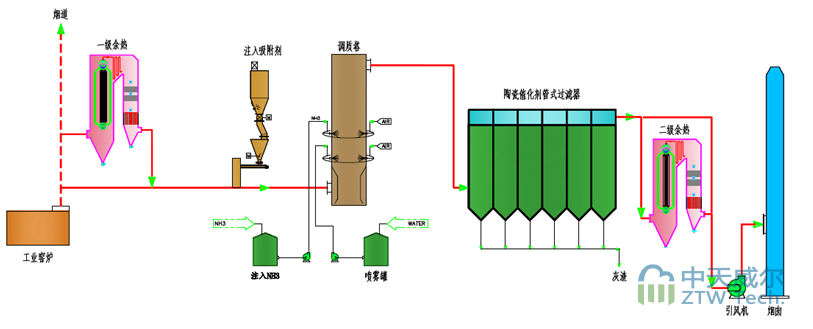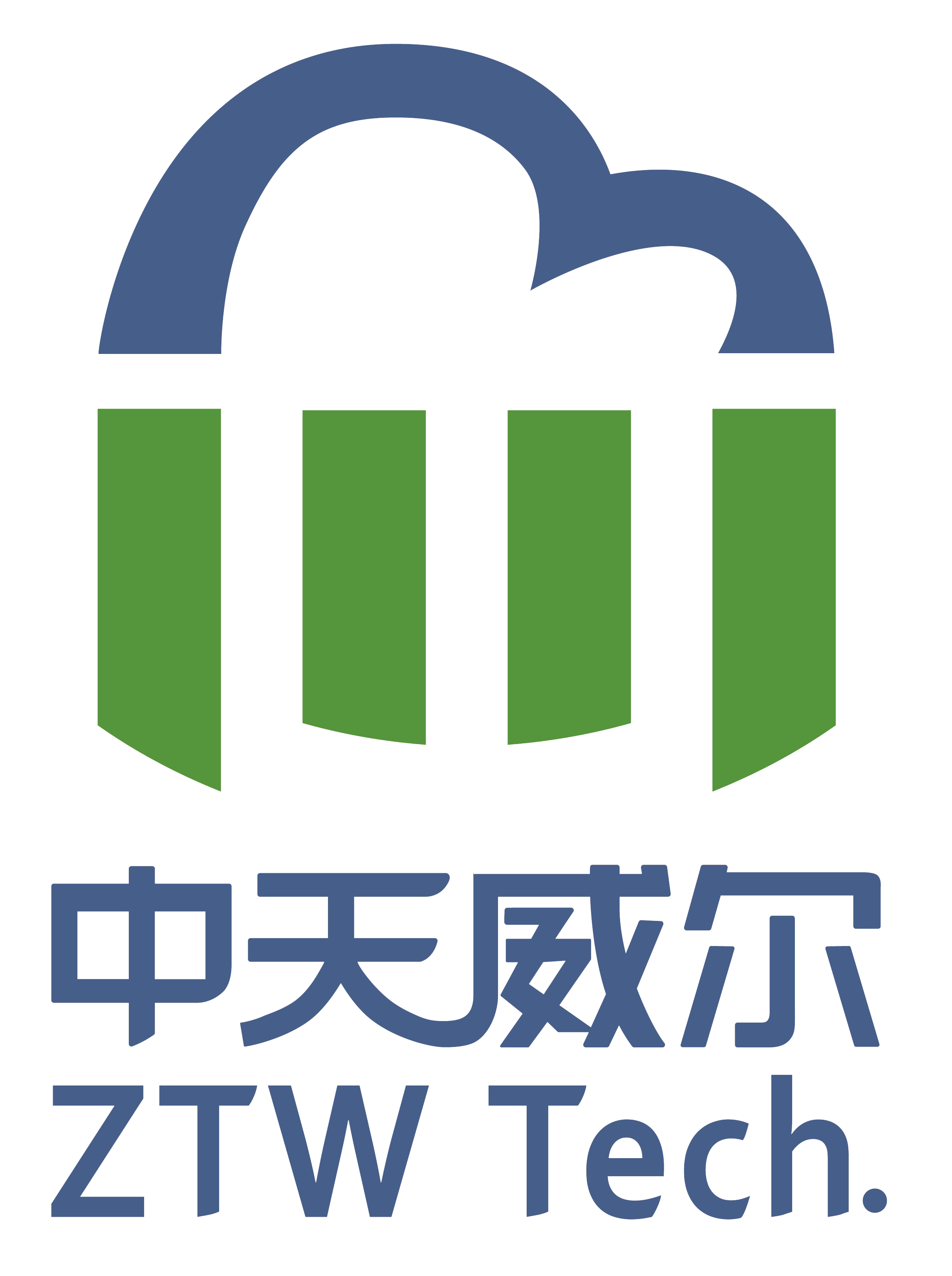Ceramic Integrated Flue Gas Treatment System
Keywords: ceramic catalytic filter tube, ceramic fiber filter tube, glass kiln, ceramic integration, dust and nitrate integration, denitration, desulfurization, defluorination, dust removal and flue gas treatment
System Overview
WK-CeraCAT ceramic catalytic filter tube pollutant ultra-low emission integrated system is a ceramic catalytic tube filter element independently developed by our company. Through the integration of core components and multi-tube bundle system, it realizes a ceramic integrated industrial kiln flue gas multi-pollutant ultra-low purification system integrating denitration, desulfurization, defluorination, dust removal, alkali and heavy metal removal. The successful application of this technology not only solves the technical difficulties of high-concentration NOx, high-concentration SO2, H2S, HF and other acidic components in industrial kiln flue gas, but also overcomes the technical bottlenecks such as catalyst poisoning and reduced activity caused by excessive alkali and heavy metal content in flue dust. At the same time, it also effectively solves the conditioning of viscous flue gas conditions, ensuring the long-term and stable operation of the integrated system.
Core technology
Based on the independently developed WK-CeraCAT ceramic catalytic filter tube technology, the company launched the world's leading ceramic integrated flue gas treatment system, which realizes the coordinated treatment of multiple pollutants such as desulfurization, denitrification, defluorination, and dust removal, achieves ultra-low emissions, and combines artificial intelligence algorithms to accurately denitrify and effectively control ammonia escape.
The core component of this technology, the ceramic catalytic filter tube, is based on ceramic fiber and is formed by centrifugal cloth process. The ceramic tube body is deeply impregnated with SCR catalyst by nano-impregnation technology to form a ceramic catalyst filter element with high-efficiency dust removal, desulfurization and high-efficiency denitrification.
Process flow
The system consists of an adsorbent powder spraying unit, a reductant ammonia spraying unit, a conditioning tower unit, a ceramic catalyst filter tube reactor unit, a waste ash treatment unit, a flue system, a control unit and an auxiliary unit. Through the synergistic effect of multiple units, efficient coordinated treatment of multiple pollutants such as NOx, SO₂, HF, and dust in the flue gas is achieved, and ammonia escape is strictly controlled. It has the advantages of simple process, easy maintenance and operation, low operating cost and long service life. Applicable to high-pollutant treatment in glass kilns, coking industry, boilers, waste incineration and other industries.

1. Pretreatment stage: flue gas conditioning and pre-removal of pollutants
Tempering tower unit: "Zhongtian Will" uses an efficient flue gas dry conditioning device to pre-remove acidic substances such as SO2 and sticky substances in the flue gas, and uses a special static mixer independently developed and produced to achieve uniform mixing of flue gas and lime powder, optimize the flue gas conditioning effect, and ensure efficient removal of acidic pollutants in the flue gas.
Adsorbent powder spraying unit: According to the user's kiln flue gas parameters, the desulfurizer is recommended to use Ca(OH)2 with a mesh size of not less than 300, a purity of >90%, and a moisture content of <0.8% for flue gas dry conditioning and desulfurization. In order to achieve efficient use of adsorbents, "Zhongtian Will" not only uses high-precision metering to spray adsorbents, but also adopts the company's independently developed anti-blocking device design to ensure smooth powder feeding and no blockage. In the flue gas transportation link, the unique WK-TZ high-efficiency conditioning tower or the WK-JT static mixer design is used in the key parts of the flue, which not only effectively realizes the uniform mixing of gas-solid two-phase flow, but also effectively improves the removal rate of flue gas acid components and reduces the use of adsorbents, and effectively controls the operating costs of adsorbents.
Static mixing unit: After the flue gas and adsorbent are fully mixed, they enter the static mixer and are evenly mixed with ammonia (NH₃) precisely sprayed by the reducing agent ammonia spray unit.
2. Introduction to pollutant synergistic treatment: integrated synergistic desulfurization, denitrification and dust removal
Reductant ammonia spray unit: Generally, 20% ammonia water is used as the reductant. The ammonia spray unit is mainly composed of an ammonia water high-efficiency atomization device, a spray gun distributor, a flue gas homogenization device and an automatic control unit. It is an important part for ammonia water to be fully atomized and evenly mixed with flue gas, which directly affects the subsequent denitrification reaction effect. The ammonia spray high-efficiency atomization device independently developed and designed by "Zhongtian Will" has unique technical advantages and can maximize the flue gas denitrification effect.
Ceramic catalyst filter tube reactor device (core link): Zhongtian Will reactor design is completely based on the German design concept of ceramic integration, incorporating the differences and flue gas characteristics of domestic glass kilns. From the reactor inlet flue to each independent chamber, the flue gas is simulated and analyzed through flue gas flow. Not only the flue guide plate is implanted, but also the guide plate design in the chamber is implanted to ensure that the flue gas entering the reactor has a uniform and smooth distribution, ensure the high efficiency of the ceramic catalyst tube multi-tube bundle and the high efficiency of the system, effectively reduce the amount of consumables, and prevent ammonia escape.
3. Waste ash treatment unit
Back-blowing and dust cleaning: Based on the high calcium-sulfur ratio of calcium hydroxide dry desulfurization in traditional ceramic integrated systems, Zhongtian Will uses an efficient and energy-saving control method through intelligent algorithms to optimize the back-blowing parameters, thereby effectively improving the utilization rate of calcium hydroxide powder.
Dust collection and pneumatic conveying device: The ash discharge port of the ceramic desulfurization, denitrification and dust removal integrated equipment is centrally collected and transported to the waste bin to ensure the cleanliness of the on-site environment and avoid personal injury to on-site operators; during the dust collection control process, according to the high-limit alarm signal of each group of reactor ash hoppers, the system starts the discharger and unloads ash according to the sequence of alarm signals. The time of each unloading cycle can be set in the reserved window of the interface.
4. Flue unit
The process pipeline unit of the front section of the tempering tower mainly includes the powder spraying process pipeline and the tempering venturi pipeline part. The process pipeline must ensure the flue gas flow rate to prevent the adsorbent from settling and causing pipeline blockage. The flue design minimizes the pressure drop of the system as much as possible, and optimizes the layout, shape and internal components (such as guide plates and guide plates at turns).
5. Control unit
The control system adopts a DCS control system, which is responsible for processing the signals detected by various detection probes and directing the operation of the entire system according to established rules.
Monitoring part - mainly displays online monitoring (CEMS) and instrument and instrument signal feedback, and adopts centralized control by the host computer.
Control system - mainly consists of power cabinet, DCS system control cabinet, frequency conversion control cabinet, field equipment control cabinet, field electrical instrument equipment, etc.
Reaction mechanism
- Remove dust from flue gas through the surface of tubular filter.
- Use lime or bicarbonate to remove SOx through the pre-coat on the catalyst tubular filter.
SO2 + Ca(OH)2 = CaSO3 + H2O
CaSO3 + ½ O2 = CaSO4
SO3 + Ca(OH)2 = CaSO4 + H2O
2HCl + Ca(OH)2 = CaCl2 + 2H2O
2HF + Ca(OH)2 = CaF2 + 2H2O
- NH3 or urea is used as a reducing agent to achieve denitration when passing through a 20mm catalytic layer, because the flue gas undergoes a denitration reaction when passing through a 20mm catalytic layer, the removal rate is high, and the NH3 escape efficiency is low.
4NO + 4NH3 + O2 = 4N2 + 6H2O
2NO2 + 4NH3 + O2 = 3N2 + 6H2O
- The decomposition of dioxin compounds can be completed in one step in the reactor without using reactants and disposing solid waste, and without subsequent treatment.
The ceramic catalyst tube filter can remove sulfur oxides, nitrogen oxides, hydrogen chloride, hydrogen fluoride, dust and dioxins in a single device.
System Features
- WK-CeraCAT series POWFRAX super ceramic filter product multi-tube bundle system integration technology is suitable for high-temperature dust removal, and the emission concentration of purified dust is less than 5mg/Nm3; it can completely replace electrostatic precipitator and bag dust removal technology;
- WK-CeraCAT series product catalyst tube multi-tube bundle system integration solves the problems of traditional SCR catalyst blockage, easy poisoning and low efficiency. In the denitrification process, ceramic filter tubes and their nano-pore tube wall filter layers are used for efficient dust removal, which not only completely solves the problems of easy clogging and poisoning caused by smoke dust on the catalyst, but also greatly improves the efficiency of denitrification and the service life of the catalyst;
- It solves the problems of low efficiency and high solid waste of traditional dry desulfurization and other acidic components. It completely solves the secondary pollution problem caused by wet desulfurization wastewater, and avoids the "white smoke" problem caused by wet desulfurization flue gas emissions.
- The new process realizes multi-chamber design and non-stop maintenance, and can realize online catalyst activation and single-chamber isolation catalyst regeneration control mode.
System advantages
System advantages
- System efficiency - Highly efficient removal of high-concentration NOx, H2S, SOx, dust, dioxins, heavy metals and alkali metal components
- Long service life - The service life of the core components of the catalytic filter tube is longer than that of the traditional SCR catalyst, with a maximum service life of more than 8 years
- Low operating costs - The operating costs of the ceramic catalyst tubular integrated system are equivalent to 60-70% of the operating costs of the traditional process
Comparison of ceramic integrated solutions with traditional processes
| Traditional SCR | Ceramic integrated flue gas purification process | |
|---|---|---|
| Process | flue gas + electrostatic dust removal + medium-temperature SCR denitrification + desulfurization tower + bag dust removal | flue gas + dry conditioning + ceramic catalyst sulfur and salt dust integrated reactor |
| Purification targe | Desulfurization, denitrification, dust removal | Desulfurization, denitrification, defluorination, dehydrochlorination, dedioxin removal, dust removal |
| Denitrification efficiency | ≤85% | ≥95% |
| Dust removal efficiency | High,≥20mg/Nm³ | Very High, ≤5mg/Nm³ (typical value: 2mg/Nm³) |
| Improvement indicators | Unable to adapt to future national standards | Ultra-low emissions |
| Stability | Complex and the stability is poor | Simple and the reliability is high |
| Catalyst life | 2-3 years (domestic catalysts need to be activated frequently) | More than 8 years |
| Pressure drop | High | Low, ≤2500Pa (typical value: 1500Pa) |
| Operation cost | High | Low(60-70% of traditional processes) |
| Investment cost | Medium | High |
| Reaction temperature | 350-420℃ | ≥200℃ |
| Occupancy area | Large | Small |
Application industry
- Glass furnaces
- Cement production
- Waste incineration
- Metal smelting
- Sewage sludge incineration
- Gasification processes
- Mineral processing
- Chemical processes
Customize the solution now
No matter what flue gas treatment challenges your industry faces, Zhongtian Will can provide a full-chain solution of ceramic integration + intelligent control + waste heat recovery to help achieve the dual goals of environmental protection and cost reduction and efficiency improvement!

